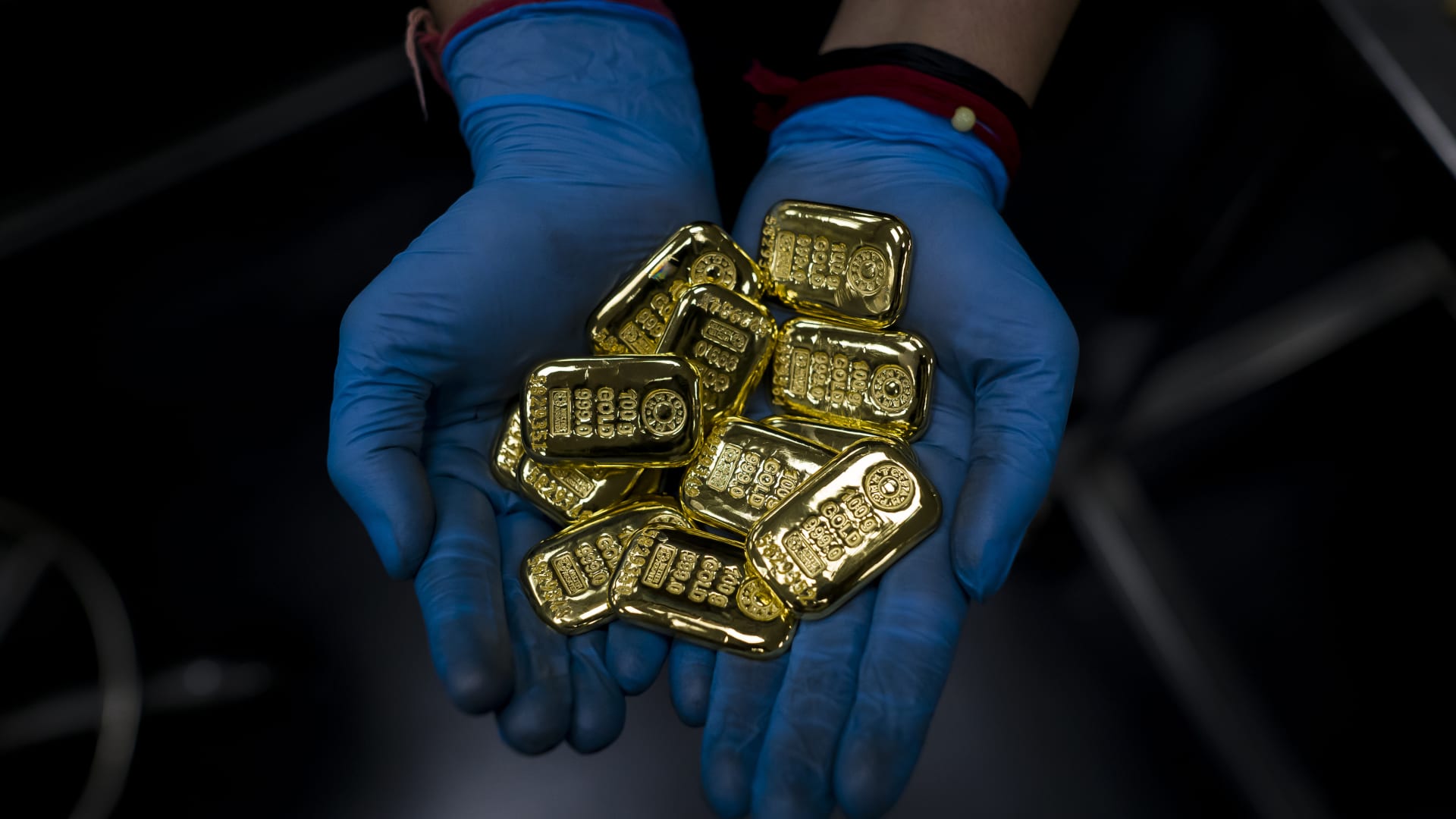Gold prices were flat in Asia trade on Wednesday as investors held back from placing large bets ahead of the U.S. Federal Reserve’s policy decision, while also keeping a close watch on the developments surrounding the Israel-Iran conflict.
Anindito Mukherjee | Bloomberg | Getty Images
The narrow lanes of Zaveri Bazaar, one of the oldest jewelers’ markets in India’s financial capital, Mumbai, grew even more congested this Diwali as crowds jostled to buy gold on the auspicious first day of the festival of lights.
But there was a twist.
Most of the people thronging the market were there to buy gold coins or bars — not jewelry — Mahavir Kothari, a wholesaler of precious metals in Zaveri Bazaar told CNBC.
Leading gems and jewelry trade bodies in India told CNBC that more than 40 tons of gold was sold in the country on Oct. 19, the first day of Diwali.
About 700 billion rupees ($8 billion) to 1 trillion rupees ($11 billion) worth of gold was sold during the five-day festival that ended Thursday, according to India Bullion and Jewellers Association, or IBJA, and All India Gem and Jewellery Domestic Council, or GJC.
Ajay Chawla, chief executive officer of one of India’s largest jewelry chains, Tanishq, reportedly warned his firm could run out of gold coins and bars due to the festive-season demand.
A few years ago, out of 10 customers, only one would opt for a coin or gold bar, said Surendra Mehta, National Secretary at IBJA, but this is slowly changing. He added that according to the estimates of his trade body, sales of jewelry had dropped by about 30% this festive season compared to last year.
The enthusiasm among Indians over buying gold for investments has been rooted in their search for returns. Gold this year had risen 66% by mid-October, before seeing a sharp slide — it was still up 55% as of Monday. Earlier this month, gold prices smashed past $4,000 an ounce, with some industry experts forecasting the yellow metal to touch $5,000 in 2026.
India is the second largest purchaser of gold after China, according to data from the World Gold Council, which shows the country has been a consistent buyer for years, driven by traditional demand for gold during the festive (October) and wedding seasons (October to mid-January and April to May).
Gold jewellery in a shop in Kolkata, India.
Sonali Pal Chaudhury | Nurphoto | Getty Images
As global central banks increase their gold purchases, fueling a surge in prices, the yellow metal is increasingly attracting retail investors who fear missing out on the boom.
Goldman Sachs in a report on Sept. 30 said that central banks, particularly in emerging markets, have increased their pace of gold purchases by roughly fivefold since 2022, when Russia’s foreign-currency reserves were frozen following its invasion of Ukraine.
“We view this as a structural shift in reserve management behavior, and we do not expect a near-term reversal,” the report said.
These sharp gains in gold prices are making Indians see gold not just as a consumption product, but a key investment asset, experts said.
Earlier, when gold demand was largely driven by consumption and prices of jewelry rose, consumers would cut back on spending, said Anindya Banerjee, head of commodity and currency markets at Kotak Securities. But elevated prices have not curbed the overall demand for gold this festive season.
Rajesh Rokde, chairman of GJC said that volume-wise sales for all five days of Diwali were just about 5% lower compared to last year, despite significantly higher prices.
Gold currently trades at $4,073 per ounce.
“India’s households wealth held in gold is estimated at $3.8tn/ 88.8% of GDP,” said Morgan Stanley in a report on Oct. 9. “This is providing a positive wealth effect, even as benign macro stability ensures that flow of gold demand remains range bound,” it added.
Gold is a good hedge against falling rupee and any weakness in Indian equity markets, said Mukesh Jindal, senior partner at wealth management firm Alpha Capital that handles assets of more than 100 billion rupees for family offices and high net worth individuals in India.
Investments include purchasing gold bars, coins, exchange traded funds and even digital gold. In September, inflows into gold ETFs rose more than six-fold to (83.63 billion rupees) from a year earlier, according to data from the Association of Mutual Funds in India.
The rally in gold is likely to continue as central banks across the world remain net buyers of the metal month on month, Jindal said, adding that he has been advising clients to allocate 5%-10% of their portfolio to gold. That is still conservative compared to Bridgewater Associates’ founder and billionaire Ray Dalio’s advise earlier this month of allocating as much as 15% of one’s portfolio to gold.
 https://www.profitablecpmrate.com/nsirjwzb79?key=c706907e420c1171a8852e02ab2e6ea4
Skip to content
https://www.profitablecpmrate.com/nsirjwzb79?key=c706907e420c1171a8852e02ab2e6ea4
Skip to content 